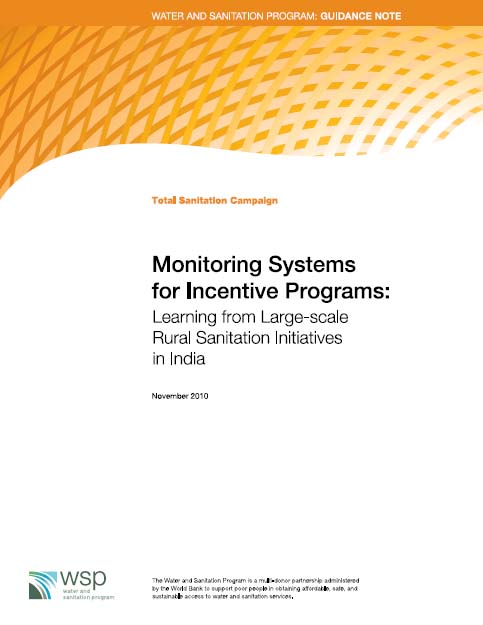 It is a part of the Global Scaling Up Rural Sanitation project of the Water and Sanitation Programme, World Bank and focuses on learning how to combine the approaches of Community Led Total Sanitation (CLTS), behavior change communications, and social marketing of sanitation to generate sanitation demand and strengthen the supply of sanitation products and services at scale, leading to improved health for people in rural areas. This is one in a series of knowledge products designed to showcase project findings, assessments and lessons learned in the project.
It is a part of the Global Scaling Up Rural Sanitation project of the Water and Sanitation Programme, World Bank and focuses on learning how to combine the approaches of Community Led Total Sanitation (CLTS), behavior change communications, and social marketing of sanitation to generate sanitation demand and strengthen the supply of sanitation products and services at scale, leading to improved health for people in rural areas. This is one in a series of knowledge products designed to showcase project findings, assessments and lessons learned in the project.
Over the last few years, the concept of open-defecation free communities has emerged as one of the building blocks toward achieving total sanitation. The term ‘access’ is widely used to capture increase in sanitation usage. However, a clean environment is a public good. Hence, there was a need to achieve total sanitation at the community level to realize public health benefits. This has led policy makers and practitioners to adopt strategies that achieve community-wide total sanitation status, which includes the community becoming open-defecation free, and adopting safe hygiene and environmental sanitation practices.
The acceptance of the concept of open-defecation free underlines two significant shifts in the approach to rural sanitation. First, it moves away from ‘counting toilets constructed’ to ‘counting the number of communities that have become open-defecation free’. Second, this signals a shift from individual household toilet construction to community-level behavior change to end open defecation as the objective of a sanitation program.
In India, the concept of open-defecation free communities, as an objective, has been a part of the guidelines of the national rural sanitation program, the Total Sanitation Campaign (TSC), since 1999. However, a major thrust was received with the introduction of national-level reward programs such as the Nirmal Gram Puraskar (NGP) and state-level reward programs by a few states such as Maharashtra (Sant Gadge Baba Gram Swachata Abhiyan) and Tamil Nadu (Clean Village Campaign).
The NGP is a one-time reward exclusively focused on motivating rural sanitation achievement. It is given to a local government once it has achieved open-defecation free status and addressed environmental sanitation in all the areas under its jurisdiction. The NGP guidelines have adopted a comprehensive definition of open-defecation free status. This is understood as the complete elimination of open defecation within the jurisdiction of a Gram Panchayat (GP, village-level local self-government), which implies that all members of a GP have access to and are using a safe sanitation facility, all schools and pre-schools have safe and functional toilets, and there is no open defecation by the floating or visitor population.
Sanitation is a public good and, therefore, a communitywide achievement of sanitation outcomes is essential for public health benefits. Incentives to local governments, against achievement of milestones or on a competition basis, are effective to drive sustainable collective sanitation outcomes. A transparent and objective monitoring of achievements is the cornerstone of a successful incentive program.
A multi-stage, multi-stakeholder verification process which is based on objective criteria ensures transparency and credibility of the verification system. A well-planned process which includes orientation of verification teams and planned for scale using decentralized systems can lead to an effective and long running incentive program.
The report presents the experience gained from the verification system instituted for the national and state reward programs in India which has some important lessons, not just for the Indian context but also in terms of replication potential.
Download the report here -